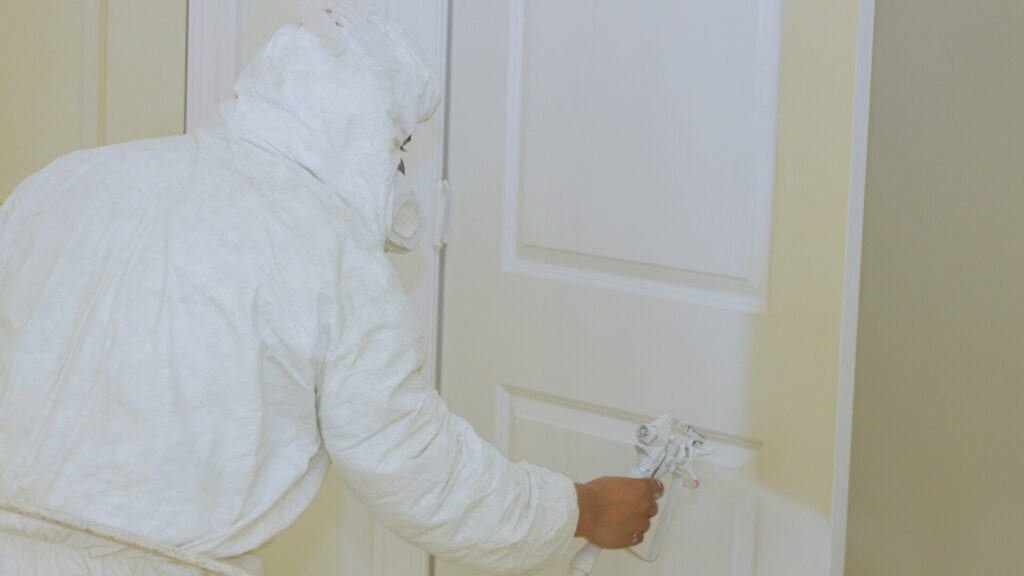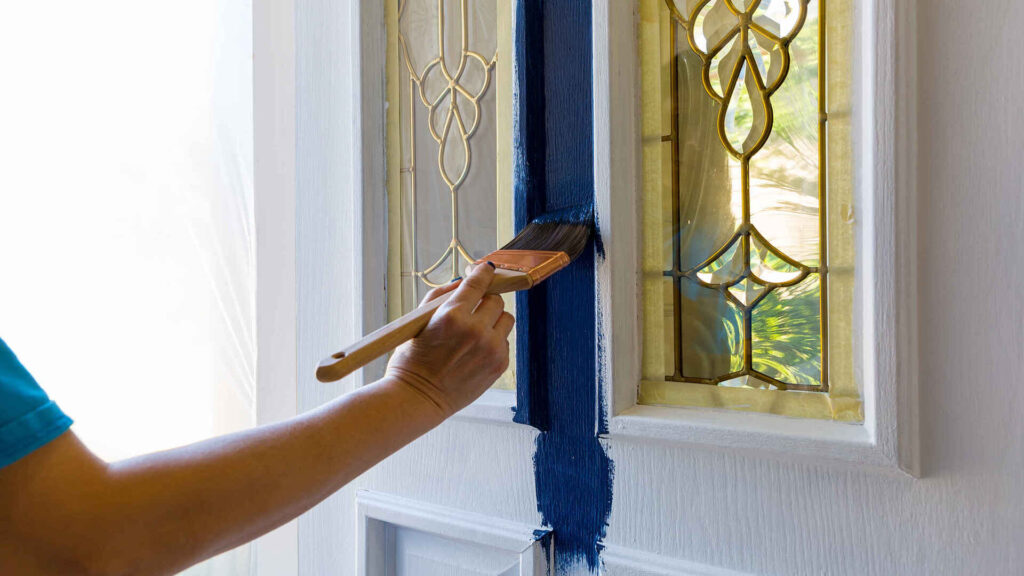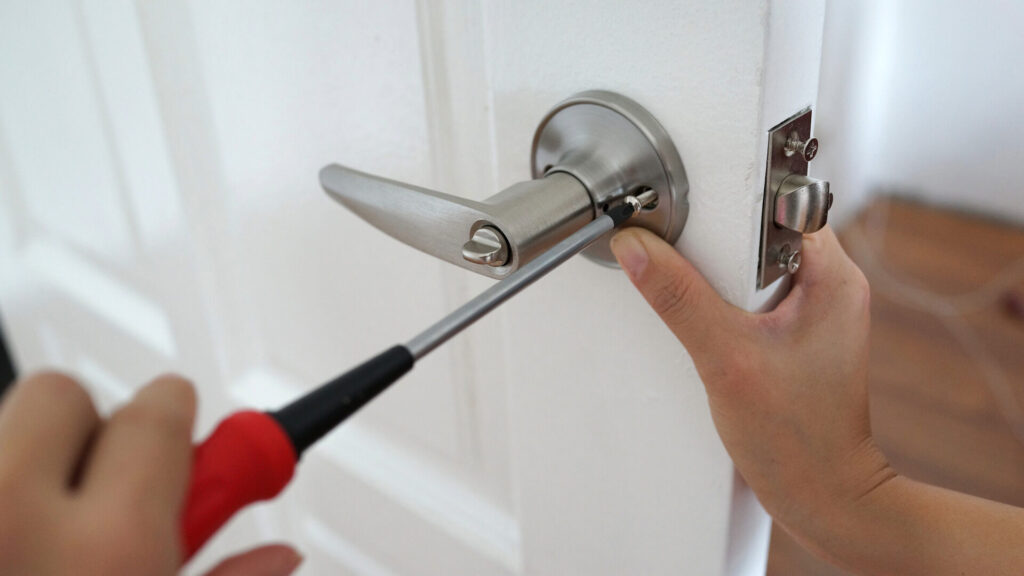To paint a door in New Jersey, prepare and sand it, tape areas, manage splatters, and consider coastal effects. Apply primer, paint, and maybe a second coat. Ensure safety, pick the right time, and clean up.

Table of contents
- New Jersey’s Climate and Its Importance in Door Painting
- Safety Precautions
- When is it time to Replace the Door?
- Choosing the Right Paint for New Jersey’s Climate
- Tools and Materials Needed
- Guide to Paint Doors
- Navigating HOA Rules and Building Codes
- Keeping Your Painted Door Durable and Long-lasting
- Coastal Considerations for Painting in New Jersey
- Conclusion
New Jersey’s Climate and Its Importance in Door Painting
New Jersey has cold winters and humid summers. This weather can affect how paint dries and lasts, especially near the coast where the salty air can make paint peel faster. It’s important to pick the right paint and time to paint doors in New Jersey to get the best result.
Safety Precautions
When painting doors, it’s essential to make sure the area is well-ventilated to clear out strong paint smells and reduce the risk of inhaling harmful fumes. These fumes, if inhaled, can lead to headaches, dizziness, or even respiratory problems in the long run. Always wear masks, gloves, and safety glasses when painting. This keeps paint off you and helps avoid skin problems, making painting safer.
When is it time to Replace the Door?
Sometimes your door may be just too old, rotten or out of style. It may be time for a new door. A new door can change the overall feel of your home and it’s personality. If it’s time we recommend going to a door showroom to review new doors that match your homes aesthetic. There are plenty of door shops in New Jersey but by far our favorite is Madison Door.
Choosing the Right Paint for New Jersey’s Climate
| Pros | Cons | |
| Water-based Paints | Dries quickly. Easy cleanup with water. Lower levels of toxic fumes. | May not be as durable in very humid conditions. |
| Oil-based Paints | Extremely durable and long-lasting. Resistant to humidity and moisture. | Takes longer to dry. Needs mineral spirits for cleanup. Stronger fumes. |
| Enamel Paints | Hard and durable finish. Resistant to wear and tear. | Takes longer to dry. |
| Acrylic Paints | Good adhesion to various surfaces. Resistant to sunlight and UV degradation. Flexible, allowing for expansion and contraction without cracking. | Might require a specific primer. |
| Chalk Paints | Provides a matte finish. Rarely requires a primer. Quick drying. | Not as durable as other types. Requires a finishing wax or sealant. |
Tools and Materials Needed
| Tools | Materials |
| Paint Brushes Paint Rollers Paint Tray Ladder or Step Stool Screwdriver or Drill Paint Can Opener & Stir Stick (Optional) Paint Sprayer | Paints (water-based or oil-based) Primer Painter’s Tape Drop Cloths or Plastic Sheeting Sandpaper Safety Gear: Masks, Safety glasses, Gloves Clean Rags or Sponges Sealants or Weather Stripping |
Guide to Paint Doors
Painting a door in New Jersey can be tricky because of the changing weather. We’ve made a guide to help you out. Also, we found a helpful video on YouTube that shows you how to do it step by step. It’s easy to follow and has some good tips. Check it out!
Getting the Door Ready
Before you begin painting, it’s essential to have a good setup. Take down the door from its hinges. To do this, you might need someone’s help because doors can be heavy. Once you take it down, place it on two blocks or stands. This position makes it easier to paint both sides. Next, use a tool, maybe a screwdriver, to take off the things on the door like handles and locks.
Consider using sawhorses. They Keep the door up at the right height making it easier to paint. Another pro tip is to cover your sawhorses with old carpet to keep from leaving marks on your newly painted doors. You can easily get carpet scraps at most major home improvement outlets.
Sanding the Door
Before painting, the door surface needs to be smooth. Using a piece of sandpaper, gently rub the entire door. Don’t rush; take your time to make sure every part is smooth. Once done, grab a clean cloth and wipe the door. This gets rid of dust or tiny bits from the sanding.
Another pro tip. If you have an air compressor blow all the dust off of the door. Don’t have an air compressor? Try a shop vac on the reverse or even use a yard blower. The cleaner the door the better it will look when it’s painted.
Taping
You might not want to paint everything on the door. For the parts you want to keep clean, like glass or some decorations, use painter’s tape. This tape stops paint from getting on them. Press the tape down firmly to make sure no paint gets under it.
Avoiding Mess
Paint can drip and create a mess. To avoid this, put a big cloth or plastic sheet under the door. This catches any paint that falls, making sure your floor stays clean.
Putting on Primer
Primer is the first layer before the real paint. It helps the paint stay on better. Using a brush, spread the primer all over the door. It’s like giving the door a base coat. After you put it on, wait for a bit. The primer needs to dry completely before you paint over it.
Painting the Door

After the primer, it’s time for the main paint. Start with the edges and small parts, using a brush. For the big, flat parts of the door, a roller works best. Roll it up and down, following the direction of the wood lines. Once you finish the first coat, let it dry. If the color seems too light or see-through, paint another layer after the first one dries.
Second Coat
Sometimes one coat of paint isn’t enough. If you can still see the old color or wood after the first coat dries, paint a second coat. This ensures your door has a fresh, solid color.
Removing the Painter Tape
This part is VERY important. Removing your paint wrong will create an ugly appearance between your hardware and the paint service. Paint Life TV made a great video on when to remove your tape and how to remove your tape.
Putting the Door Back

Once everything’s done, there’s always a bit of cleaning to do. Wash your brushes and rollers with water so you can use them again next time. Seal your paint cans tightly so the paint doesn’t dry out. If you have extra paint, label the can and store it somewhere safe. You might need it for touch-ups later. Lastly, throw away used tape, cloth, and empty cans.
Another pro tip. Store your brushes in old coffee cups with water! My favorite is a used Starbucks cup. A perfect chance to recycle.
Cleaning Up
Once everything’s done, there’s always a bit of cleaning to do. Wash your brushes and rollers with water so you can use them again next time. Seal your paint cans tightly so the paint doesn’t dry out. If you have extra paint, label the can and store it somewhere safe. You might need it for touch-ups later. Lastly, throw away used tape, cloth, and empty cans.
Navigating HOA Rules and Building Codes
In New Jersey, if you’re part of an HOA or in certain areas, there are painting rules to follow. HOAs might have specific color rules, while building codes ensure safety. Always check both before painting to avoid problems or having to repaint.
Keeping Your Painted Door Durable and Long-lasting
- Inspecting the door: Regularly check for signs of wear, like chipping, fading, or peeling, especially after harsh weather conditions.
- Cleaning: Wipe the door gently with a damp cloth to remove dirt and dust; for stubborn spots, use a mild detergent mix, then rinse and let dry.
- Touch-ups: If you spot minor damages or chips, touch up the paint using a small brush, ensuring you use the same paint type and color.
- Protecting against elements: For doors exposed to a lot of sunlight, consider applying a UV-resistant clear coat to prevent fading.
- Weatherproofing: Apply sealants or weather stripping to edges, especially if exposed to New Jersey’s variable weather, ensuring the paint remains protected from moisture.
- Reapplying: Depending on exposure and wear, consider repainting the entire door every few years to keep it looking fresh and protected.
Coastal Considerations for Painting in New Jersey
Living near the coast in New Jersey comes with its own set of challenges for painting. The salty air from the ocean can make paint wear out faster. Therefore, if you live near the sea, selecting paints that resist both salt and moisture is wise. Consequently, this decision ensures your paint remains vibrant and durable for an extended period.
Conclusion
Painting a door in New Jersey means thinking about the weather and the sea. Cold, wet days and salty air near the beach can change how your paint looks and lasts. Picking the right paint, knowing the best time to paint, and being safe while doing it helps make the paint look good for a long time.
If you like watching more than reading, we have a YouTube video that offers a guide on how to paint. This way, your doors will look great and stay that way for years, even with New Jersey’s tricky weather and sea air.
Fact checked by Christinne Somo – 10/10/23